CGC Field of Glory
After Action Reports
Roll On Sweet Chariots
Battle of Arsuf: Saladin vs. Richard the Lion Hearted
Barbarian Balkan Bash…
Three Battles in Two Days
For an introduction to Field of Glory, click here
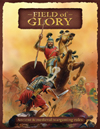
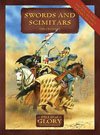
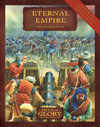
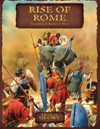
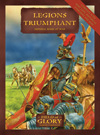
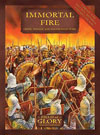

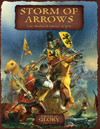
Roll On, Sweet Chariots
Oct 5 2008 By Mark McLaughlin
Finally, after weeks of painting, a chance to use MY OWN chariots – and all of
them!
In looking for a combination that would allow me to use all 17 light and 6 heavy
chariots I came across the Kyrenean Greeks – they had a colony on the Libyan
coast and, along with Libyan allies, fought pre-Hannibal Carthage, Ptloemaic
Egypt, other Greeks and, of course, Romans. And as I was going to James’
place and he has Romans…..well, you know, it just seemed a good fit.
The Kyreanean Greeks were the main force – 6 superior heavy chariots, a 12-base
phalanx, 4 six-base hoplites, a unit of Poor javelins and the Guard – six
superior armored lancers, and two generals (troop and field commanders, could
not afford an inspired leader). Libyan allies have only two types of units ---
light chariots and light infantry javelin. Bought 16 of each…and my 17th
chariot, the one with dear queen boudica herself, became the allied
general…total:850 points.
James put out early imperial Romans rather than his Republicans for a change.
Two units of light infantry archers, two of light cavalry bows, a solid six base
superior armored cavalry and eight six-base legions…plus a unit of six spearmen
and one of gladiators…..for whom he bought enough field fortifications to give
them an all around fort.
James won the initiative and choice of sides on a desert battlefield with gently
sloping dunes all around, and a piece of rough terrain on each flank. He
intentionally deployed in an incredibly tight mass in the northwest quadrant of
the field, using his camp and field fort to anchor his left or eastern flank.
I spread my army out. My hoplites and pikes opposite his legion bloc, my heavy
chariots in the center and all the Libyans on the right (east). The Cavalry
was my central reserve.
I raced forward, intent on keeping James hemmed in….he made no effort to spread
out, which actually caught me off guard…..as he had a heavy infantry army and I
the mobile one, he decided to put himself in a position where he could not be
outflanked….he actually used his light cavalry to try and outflank my left,
coming around the rough ground in the west…..as the front was limited, I turned
my lancers to the left and rode them double speed with a general behind my left
to block his light horse….that and a unit of hoplites I had left behind my main
battle line for that purpose, together chased them off….expensive troops to
shove aside weak ones, but it was no ground for chariots….who take up a LOT of
room.
My chariot horde swept forward as my spears and pikes advanced steadily. One
chariot unit drove off some Roman light infantry bows and hurtled into a legion
and the cavalry….it was a massacre…my chariot unit literally did not survive my
own turn…one base died in the impact, two others in the melee, and last had to
autobreak away…all without scratching the Romans (I rolled mediocre, they
rolled savagely)
Fortunately for me, my infantry did much better. My Phalanx and two hoplites
engaged the Romans on my left…Their medium infantry spears broke, one legion
autobroke, I killed TWO generals and then the heavy chariots joined in and
another cohort fragmented…..one of my hoplite groups died, as did a little
general leading it, but we were moving forward, pikes and heavy chariots
shoulder to wheel…
Meanwhile, my right swung around, chased away some more lights and was bearing
down on his camp….and my hoplites on the left had pushed his horse back beyond
the rough, and with my flank secure, I turned the lancers in toward the center…
At this point, James offered to concede. Although I was only slightly ahead on
points at this instant, James’s army was in a backwards L shape, and I had
smashed one side of the L, and thus could outflank or threaten to outflank the
other side….
Dice in combat initially favored James (especially in the fight against my over
eager light chariot unit) but I made most of my morale checks…and James did not
make enough of his….
It was not the full test of chariots I had hoped for – James smartly deployed to
minimize my ability to use them – and my guard armored superior lancers never
even broke into a sweat….the battle was won by the poor bloody infantry,
especially those of the phalanx, but as the nobles all rode to battle in
chariots, they of course claimed the credit….
BACK TO TOP
Battle of Arsuf After Action Report
Saladin vs. Richard the Lionhearted
By James Sulzen
June 21, 2008, Great Barrington, MA
Fields of Glory ® Rules
jamesldt@yahoo.com
Click here for a pdf file of this after action report

We had a swirling knock-down-drag-out fight at Ed R.'s lovely wargaming Nirvana up in Great Barrington, MA this last Saturday - the Christians of the Third Crusade (the Right True Believers) taking on the Turks of Saladin (Unwashed Infidel That They Be). Guess who got to write the History on this one ...
This description took me way too much time, but every now and then one just has to take time out to do something uselessly creative and silly .... Please do feel free to pass it on to whomever you think interested.
James
Background to the Battle
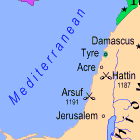 The Christians, after their July 12, 1191 capture of Acre, led by King Richard Edward of Reg en Dahl the Lionhearted and seconded by his able subordinate Baron James of Sul et Zen, were marching south from Acre to liberate Jerusalem (see map below). Richard, having carefully studied previous campaigns in the Holy Land, marched his army and a large baggage train along the coast with his fleet closely in support paralleling the army's movements. Saladin (Salah al-Din Yusuf ibn al Marq mac Lauf-lin), leader of the Turk's and conqueror of Jerusalem, had been attacking and harrying Richard's march. On September 7, 1191, ibn al Marq ne Saladin launched a general attack as the Christians approached the ruined city of Arsuf.
The Christians, after their July 12, 1191 capture of Acre, led by King Richard Edward of Reg en Dahl the Lionhearted and seconded by his able subordinate Baron James of Sul et Zen, were marching south from Acre to liberate Jerusalem (see map below). Richard, having carefully studied previous campaigns in the Holy Land, marched his army and a large baggage train along the coast with his fleet closely in support paralleling the army's movements. Saladin (Salah al-Din Yusuf ibn al Marq mac Lauf-lin), leader of the Turk's and conqueror of Jerusalem, had been attacking and harrying Richard's march. On September 7, 1191, ibn al Marq ne Saladin launched a general attack as the Christians approached the ruined city of Arsuf.
Order of Battle
Christians (11 units)
1 x Inspired Commander (Richard Edward of Reg en Dahl the Lionhearted)
3 x Troop Commanders (James of Sul et Zen plus two other nameless fellows)
3 x Knight Lancers (armored, 4 bases)
4 x HF (armored, offensive spears, 6 bases)
3 x MF (crossbow, 6 bases) 1 x HC (4 bases)
1 x Artillery (support from the fleet, 2 bases)
Turks (15 units)
1 x Inspired Commander (Saladin) 3 x Troop Commanders
- Spera ali ben Phil
- The Warrior Princess Lady Robyn of Acquitane*,
- ... and some third nameless minion
4 x Mamelukes (HC drilled armored lancers, 4 bases, the elite of Saladin's forces)
3 x HC Lancers (armored, 4 bases)
4 x LC (bow, 4 bases)
3 x LF (bow, 6 bases)
1 x MF Untrained Levy - otherwise known as 'The Mob' (unarmored, undrilled, poor morale, 8 bases)
*Note: The Lady Robyn had been captured in earlier fighting by ali ben Phil's forces, but on her ransom having been paid, she, having been in the meantime won over by the martial charms of ali ben Phil, refused repatriation, resulting in ibn ben Phil receiving both the treasure and the woman. She, being of warrior stock herself, insisted on campaigning and commanding with her betrothed for "the fun of it. "
1. Salah aI-Din Yusuf ibn al Marq mac Lauf-lin and Baron James in pre-battle palaver:
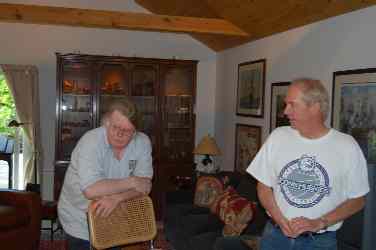
2. ali ben Phil plans his attack:

Note: File photos of Richard Edward of Reg en Dahl, alas were not available. The Lady Robyn demurely appears in a battle scene photo later in this account.
Pre-Battle Organization and Maneuver (see map below)
The Christians were arrayed in march order to closely protect the baggage train, heading south along the coast with a row of hills covering their inland flank. Richard (Edward of Reg en Dahl) placed the baggage train in the center of the force with a solid array of heavy infantry and medium crossbow covering the inland flank. Other forces in the vanguard, commanded by Baron James, consisted of the Anglo-Norman knights, a battle group of crossbow, followed by the Knights Templar. The rear, commanded by Richard himself, consisted of a heavy infantry battle group, the Knights Hospitaller, and a unit of heavy cavalry bringing up the rear.
Saladin (ibn al Marq) attacked from inland with a force heavily weighted with cavalry as was the Turk's typical practice. He put his best forces on his right, four battle groups of Mamelukes, under ali ben Phil's command. On his left under his personal command, he had the remaining heavy cavalry (three battle groups of armored lancers). His center, commanded by the Lady Robyn, consisted primarily of light forces anchored by The Mob. The entire Turk front was well screened by light cavalry and light foot forces.
ibn al Marq's plan was for the forces under his immediate command on the right to act as an anvil to cork the Christian advance, while ali ben Phil's forces, the hammer in the plan, swept in and crushed the Christian rear. The Turkish center was to harass and tie die their opposing number to prevent the Christian center from supporting either the rear or the van. It seems in the end, only the center achieved its objectives, but not before the Christian day very nearly ended in disaster.
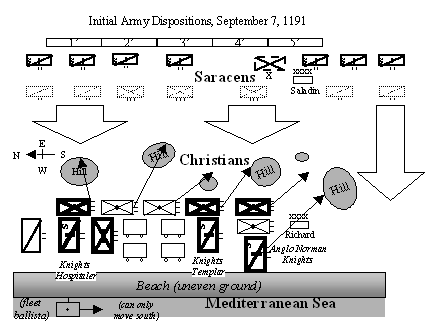
Note: A complete list of the unit symbols above can be found at:
http://homepages . uconn.edu/-jas01 033/gaming/map-symbols.gif
Opening Moves
The Saracen left under ali ben Phil swept down towards the Christian rear, but due to pre-battle miscommunication among the Saracen commanders, chose to harass and harry Richard rather than attempt to close and destroy him, thereby losing valuable time in developing the battle to the Turkish favor. Saladin's own cavalry cut in front of and halted further advance of the Christians, thereby starting to fulfill his part of the overall plan. Lady Robyn's forces advanced on the Christian center, forcing the Christian's inland flank-guard to defensively deploy along the hill line. In the Christian advanced-guard under James, the Anglo-Norman knights supported on their left flank by heavy infantry deployed to screen the Turkish forces blocking the Christian advance towards the city of Arsuf; the Knights Templar, the cream of the Christian forces, moved to support the Anglo-Norman knights. In the Christian rear, Richard deployed the Knights Hospitaller and his other cavalry, thereby intimidating further advances of the Mamelukes under ali ben Phil.
3. By the end of the opening moves [turn 3J, the battlefield appeared as below, looking from the north towards the south.
(Note that some forces in the north are not seen.)
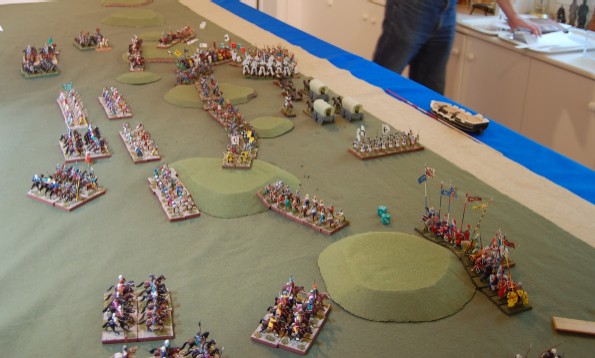
4. View from the south looking north, also as of the end of turn 3:
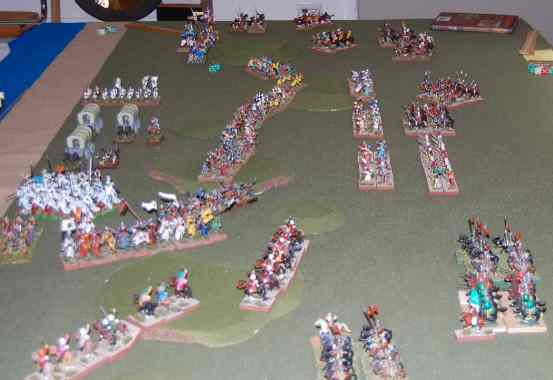
The Battle Develops
Richard, seeing his rear was not being seriously threatened by ali ben Phil, and seeing also that the baggage train had moved significantly further onwards, ordered the Knights Hospitaller to simply reform and head south after the baggage. In the center, desultory bow fire was maintained between the Christians and Saracens. To the south in the Christian van, Saladin attempted to draw the Anglo-Norman knights out where they could be cut to pieces from all sides, but James, spying the trap, closely held the Anglo-Normans in check until the Knights Templar force could come up on their right in support.
5. Following shows the battlefield from the south as of the end of Christian turn 6:

(Note. Saladin is the lone figure in the center foreground to the right of the Turkish cavalry line; he has a green flag and his back is to the camera. The Anglo-Norman knights are facing the camera and are deployed in a single rank on the back side of the hill in the foreground; the Knights Templar are the white figures just behind and advancing on the seaward side of the Anglo-Normans. There is a battle group of Christian crossbow men advancing along the beach just in front of the Templar, covering the Templar’s seaward flank.)
The Battle is Joined
Saladin, concerned that he was not seeing the aggressive spirit his battle plan expected of ali ben Phil's Mameluke lancers (the Saracen hammer force), hurriedly conferred with ali ben Phil to put fire into the attack on the Christian center and rear. With Saladin's stinging rebuke echoing in his ears, ali ben Phil hurled two of his four Mameluke units upon Christian crossbow formations poorly prepared to receive such furious assaults. Richard, seeing his center and rear about to crumble, brought the Knights Hospitaller in close support of the crossbow formations, prepared to thwart any break-through by the attacking Mamelukes.
6. Mameluke assault on the Christian center and rear (view looking from the north):

At this point, Baron James at the Christian van was able to launch the creme de la creme of European knighthood, the Knights Templar, upon the Saracen heavy cavalry that was blocking the advance of the baggage train. With Christian crossbow men simultaneously advancing along the beach and threatening the Saracen cavalry flank, things were looking grim for Saladin's own personal command. The rest of the forces in the Christian van continued to screen the baggage train, forcing the Saracen enemy to stay well back from the intimidating display of Christian martial might.
7. The Knights Templar attack (view looking from the south, Templar are the white figures to the left):

Unfortunately, the Templar were slow in advancing, maintaining an intimidating but measured pace rather than charging with their usual élan [as in obtaining the poorest possible die roll for the charge distance ... ed.]. This delayed the Templar attack sufficiently for Saladin to rush a cavalry lancer battle group from his right around to support his left, simultaneously bringing up light cavalry along the beach to counter-threaten the flank of the Christian crossbow men on the beach. Simultaneously, Saladin used other light cavalry to maintain an annoying fire upon the Anglo-Norman knights, trying to irritate them sufficiently to tempt them into the still waiting trap (see notes in photo below). Despite the delay in the Templar attack, the Templar were making short work of the vastly inferior heavy Saracen cavalry, but still taking sufficiently long so that Saladin had time to shore up his aforementioned crumbling left flank. The Templar did however manage to slay the nameless infidel general leading the lancer battle group opposed to the Templar.
8. Saladin rescues his left flank (view from the south):

Meanwhile, of the two Mameluke units ali ben Phil had ordered into immediate attack , a Christian crossbow unit holding steady repulsed one in the Christian center. The other Mameluke unit, attacking toward the Christian rear was making short work of the crossbow unit that they were up against. Richard, anticipating imminent collapse of these later crossbow men, extended the line of the Knights Hospitaller behind and in immediate support. Despite the rapidly deteriorating situation of the crossbow, help was on the way. The Christian heavy cavalry covering the extreme rear, having disposed the enemy opposed to it, rushed to strike the flank of the imminently victorious Mamelukes.
Alas, the heavy cavalry would arrive too late to succor the hapless crossbow, doomed as they were to be destroyed under the hooves of the victorious Mamelukes.
9. Swirl of battle in the Christian center and rear (view from the north):

Disaster Threatens
Unfortunately, at the rear of the Christian position, Richard had deployed the Knights Hospitaller too close behind the crossbow that they were supposed to support. The crossbow, when they broke, routed directly through the ranks of the knights, thereby throwing the knights into disorder [the knights dropped a cohesion level for being routed through - ed.] This proved a serious tactical error on the part of Richard as the Knights never recovered from this disorder. However, the knights despite their disorder and with the help of the Christian heavy cavalry, were able to charge and dispose of the Mamelukes causing the crossbow rout, as well as routing one other Mameluke unit brought up in support. However, while the knights were busy to their front, disastrous developments were occurring to their right in the Christian center.
The Mameluke unit that had been earlier repulsed in the center again charged, and this time was victorious against the same crossbow unit that it had earlier charged. These Mamelukes, after this easy success, turned to charge the Knights Hospitaller rear.
10. Disaster threatens the Christian rear (view looking from the north):
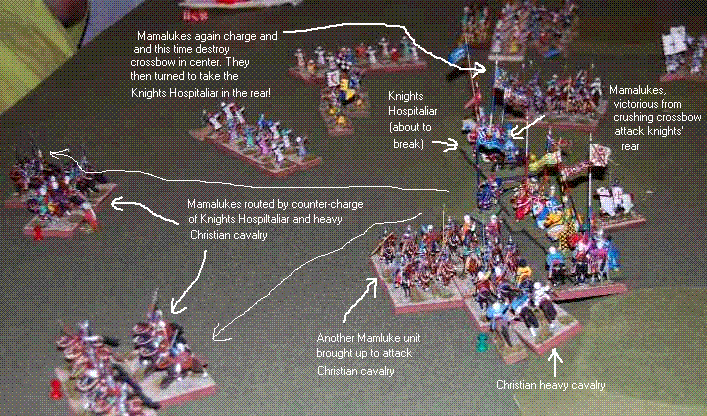
In the van of the battle, the Knights Templar were chewing up the Saracen heavy cavalry, as very much according to Saladin's original battle concept to tie up the Christian heavy combat units. Unfortunately, this self same cavalry was being personally led by Saladin himself, an element not exactly in the original plan. Regrettably, for the Christians, the crossbow unit defending the beach, assaulted by desperate attacks to its front from the shreds of the Saracen heavy cavalry and threatened in the flank by Saracen light cavalry, broke and routed back up the beach. This left a gaping hole for the Saracen light cavalry to charge through, directly towards the exposed Christian baggage train. Baron James, though personally leading the Templar, seeing the desperate circumstances occurring to his beachward flank and rear, sent messengers out to the rest of the army calling for all elements to come to the succor of the defenseless baggage train.
11. Saracen Light Cave breaks through, while the Knights Templar is destroying Saracen Heavy Cave:
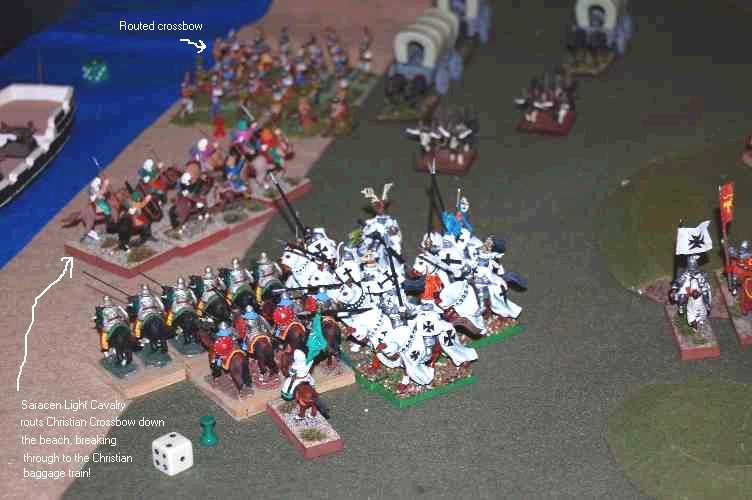
However, desperate as circumstances appeared for the Christian van, matters were more personally desperate for Saladin as the Templar hacked and chopped at the few remaining Saracen lancers separating him from the Templar.
12. Saladin looks pensively on, as the Knights Templar destroy his Heavy Cavalry; Lady Robyn attempts to demurely hide in the Great Man's shadow:
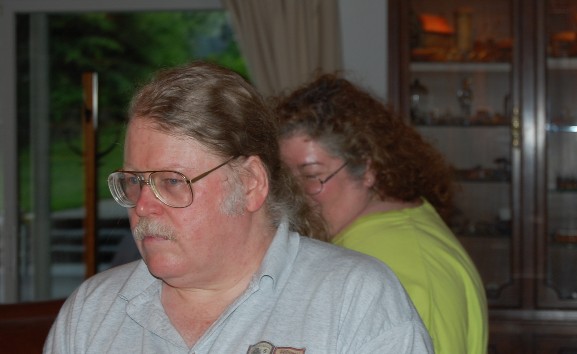
Then, at the height of the battle with the Saladin's cavalry unit, Baron James at the head of the Templar, spying Saladin in the melee before him, cut his way through the remaining Saracen lancers and slew Saladin in single combat, breaking the enemy lancers and routing them from the field.
13. Death of Saladin:
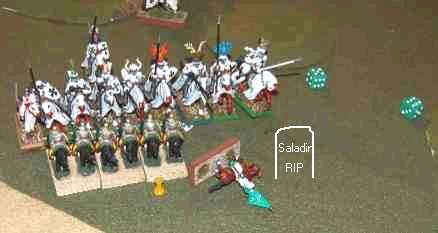
Unfortunately, by this time the loss of Saladin had little if any impact on the battle as the Saracen light cavalry were already behind the Christian line and heading for the baggage train.
The Christian Position Starts to Crumble
At the rear of the Christian position, the Saracen Mameluke cavalry was about to complete the destruction of the Knights Hospitaller and of the remaining Christian heavy cavalry (see photo below). The Saracen light forces in the center, following their dead leader's original battle plan, had managed to draw out the remaining Christian center forces, leaving those forces scattered and little able to come to each other's assistance or to the assistance of the threatened baggage train. The scattered Christian forces also left gaping holes in the Christian line, allowing the enemy light units to poor through.
14. Christian rear is about to fall; Christian center is scattered:

15. The Christian rear collapses:
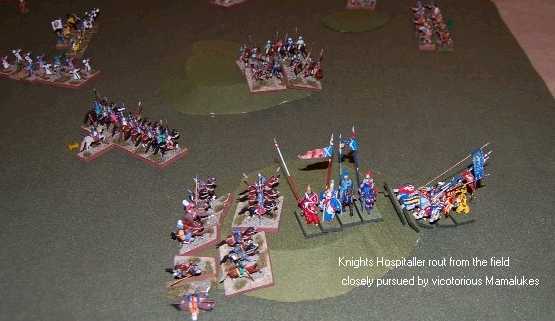
The Crisis
The Christian situation looked desperate, even with the buoy in morale as word of the infidel leader's death spread through the Christian ranks. Enemy light cavalry was looting among the baggage wagons. The rear had collapsed, enemy light forces were pouring in through holes in the Christian line, heading straight for the baggage train, and without the treasure in the train, Richard's entire Levant strategy would collapse no matter how many subsequent victories he might win.
16. Saracen light forces head for Christian baggage train:

In this moment of crisis, the scattered Christian forces heeded Baron James' call for defense of the baggage train. The fleet, arriving just in the nick of time, poured red-hot ballista fire upon the Saracen light cavalry that had broken through along the beach, fragmenting and threatening to destroy the hapless cavalry with the fleet's shooting alone. Richard, rushing back to the train, rallied the routing crossbow unit still on the beach and headed its unsteady members back to the defense of the train. The Anglo-Norman knights about-faced and headed for the baggage train, cutting off in-land escape of the looters. Heavy foot, rushing up from the rear guard, charged among the baggage train, threatening annihilation to all would-be looters. The Knights Templar also about faced and charged, threatening to run down the looting light cavalry.
17. Christian forces rally to the baggage train:

Unfortunately, the sudden rush to the center by the remaining Christians left their rear open for Saracen forces to charge in upon. The Christian position seemed about to completely collapse.
18. Saracens chase Christians back to the baggage train:
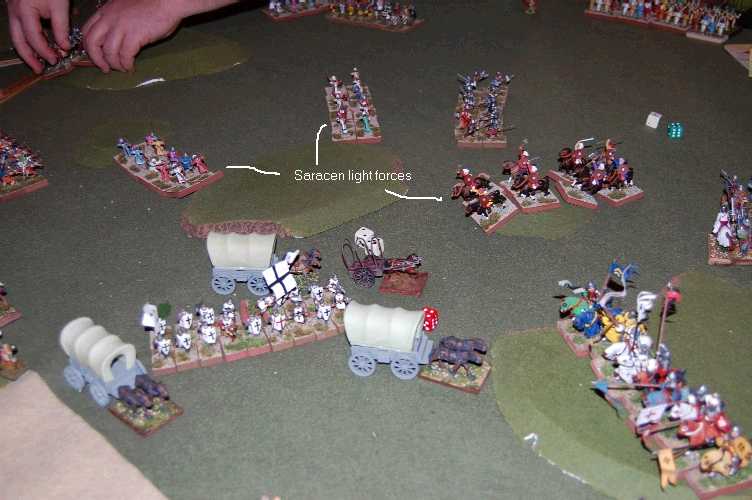
 Fighting in and around the supply wagons was desperate as the Christians sought to eject the one light cavalry unit that had actually managed to reach and loot part of the train. However, in mere moments much of the rest of the Saracen forces were going to be upon the disorganized Christians with general melee occurring in and among the wagons, leading to certain destruction of Richard's treasure. It is in the moments of crisis such as this that great leaders show their true mettle, when the force of great moments hangs by the slimmest of balance. Richard, rather than panicking and heading for the safety of the fleet as he might so easily and justifiably done, instead bolstered the crossbow men he was with, turned them about and ran down the enemy light cavalry before them, destroying most and scattering the rest. The rest of the Saracen army, seeing their comrades streaking from among the supply wagons lost heart and they too turned and fled rather than face the further wrath of the God-fearing Christians.
Fighting in and around the supply wagons was desperate as the Christians sought to eject the one light cavalry unit that had actually managed to reach and loot part of the train. However, in mere moments much of the rest of the Saracen forces were going to be upon the disorganized Christians with general melee occurring in and among the wagons, leading to certain destruction of Richard's treasure. It is in the moments of crisis such as this that great leaders show their true mettle, when the force of great moments hangs by the slimmest of balance. Richard, rather than panicking and heading for the safety of the fleet as he might so easily and justifiably done, instead bolstered the crossbow men he was with, turned them about and ran down the enemy light cavalry before them, destroying most and scattering the rest. The rest of the Saracen army, seeing their comrades streaking from among the supply wagons lost heart and they too turned and fled rather than face the further wrath of the God-fearing Christians.
Entered in the Annals of Richard, this day, the 23rd of June in the two thousand and eighth year of Our Lord,
Scribe jts
[Editor's note: The breaking of the Saracen light cavalry on the beach was just enough to put the Saracen army over its break limit, thus ending the battle. Final score: Christians 9, Saracens 15, leading to a Christian marginal victory.]
BACK TO TOP
Barbarian Balkan Bash…
CGC July 12 2008 By Mark McLaughlin
 One of the guys at the club says you shouldn’t even bother shooting in FoG…too bad he had to leave before the end of the game when the barbarian archers and javelins got together to massacre the Greek armored lancers, the best unit still on the table….but we’ll get to that…..
One of the guys at the club says you shouldn’t even bother shooting in FoG…too bad he had to leave before the end of the game when the barbarian archers and javelins got together to massacre the Greek armored lancers, the best unit still on the table….but we’ll get to that…..
Once again a teaching game. Three guys who had played FoG for the first time last week (Tom Cusa, John Demeter, John Manning), plus the DBA grandmaster, Roland, “lucky” John Pasaglia, the-like Andy-I’m not moving from my chair once I sit here-Greg and my favorite barbarian, Mad Mike.
900 points a side. Successors vs Germans. Messy
terrain. I set out steep hills, woods, a large area of plowed fields around a ruined town and even a river
on a third of the table. The Successors did have a
good solid open field they could fight on, just constricted if they wanted to advance. To the Germans, most of whose men could care less about terrain, the land was, well, almost home.
Scouting points were the same, as both sides had an inspired commander and 24 bases of cavalry – the Germans had two good 6-base units of nobles, superior but only protected (ie a shield and helmet), while the Greeks had two 6-base armored lancers, plus a superior
armored cavalry. Germans had three small light horse
units, the Greeks two. The centerpiece of the Greek
army was a 12-base phalanx, supported by 4 heavy hoplite and one Thracian medium unit. The Germans had two units of heavy infantry (my newly painted naked gauls, with heavy being formation/fighting style, not weight of armor, which is separate) and five big
clunky chunky medium units, all impact foot. Both
sides had the usual cloud of skirmishers, with each side having an archer and the greeks, at least,
slingers as well. The Germans had one more general
than the greeks, but only one Barbarian was good, the other three were just little local guys.
Greeks set up in the open center, then put horse to
the flanks. Barbarians spread out in four battles:
Greg’s horde behind the river, mad mike’s left of center horde, roland with the main horde right of center, and manning with all of the cavalry on the
right. Demeter sent Pasaglia racing forward to try
and overthrow Manning, had Tom and his horse dare Greg to cross the river, and hurled his own skirmishers in a cloud at mad mike.
Things did not go well for the Greeks right from the
start. Manning out diced Pasaglia badly, managed to
use two light horse units in a sacrifice charge (disordered by terrain coming down a steep slope into the Greek horse) to allow a third to come in on the flank of the Greek heavies….that plus dice wiped out one lancer unit, and for the price of one of his own light horse then managed to smash pssaglia’s two lights and even kill his general….and losing one of only three generals in a big 14-unit (well, now 11
unit) 900 point army is serious.
Mad mike threw back the skirmish cloud and slammed into the hoplites and phalanxes and thracians….piecemeal…yet somehow just did not die….
Greg crossed the river, tom charged…and his lancers and cavalry bounced.
At this point, as with one game last week, Demeter’s personal morale broke and he was all for throwing in the towel….
But it was early, the armies had a long way to go to break, and the greeks, being drilled, can respond to threats in ways no barbarian can dream of ….
So we kept playing. Unfortunately manning had to leave to deliver a baby and roland had to go, so Pasaglia, who like pickett now had no division, became the german right.
Pasaglia swung his cavalry, light horse, javelins and a horde unit on a sweep across the wide expanse of plowed fields to come in on Demeter’s flank….but the drilled greeks had time to turn, face, move, deploy….Pasaglia, however, smashed and routed one big hoplite unit with his cavalry – no mean feat, but superior troops led by an inspired commander can work wonders…
In the middle, however, mad mike’s horde broke…and routed through the heavy naked infantry….disordering them. As Pasaglia had two generals to push on with his flank move, Mad Mike had to make the choice…try to rally one big routing unit or try to bolster the heavies….he tried the rally bit, again and again and
..well, five times, and they all failed. He then
rode back and rallied the german heavies, who were facing down the phalanx…and true stalemate of 12 vs 12 bases of the cream of both sides infantry.
Gregg‘s attack on the river flank started well, but the two cavalry units plus a hoplite broke one
warband. The cavalry chased them into the river, but
there ran into a hail of fire from archers and mad mike’s javelins…..the unit failed morale, got stuck in the river and could not charge, went to fragmented, turned about and tried to get out of the stream to the safe side…but one last volley wiped it out.
Finest unit on the field, done in by barbarian archers and javelin men….
The game was very close now. The Greeks were down and one more breaking unit would do them in….but then a Barbarian unit broke in its battle with a hoplite, it ran through three disordered units, making them fragmented (fragmented is worth 1 point, routing or dead 2) thus bringing the Germans to the same status as the Greeks….sudden death, next unit to break would mean the game….
And that next unit was the heretofore victorious german noble cavalry. The unit that had slaughtered the armored lancers, chased down light horse, sweep around to come in almost behind the greeks, swept aside archers and javelins and then annihilated a hoplite unit in face to face mano a mano combat….well, even with an inspired leader, a unit can only do so much in a day….
It was a good close game that looked very bad for the greeks, got worse, then turned to even and then …
A marginal and bloody close called combat.
And yes, there was far more terrain than “the book”
would have in a typical tournament battle….but just
how many drill fields are there in the Balkans?
It was good to learn how a hoplite/phalanx army fights against barbarians…and even with 900 points, four guys who had never played, one who had played once and two who had played only twice, we fought to a conclusion in just over four hours….
BACK TO TOP
 John Manning invited me to his house to teach Field of Glory to some of the CT game club guys – guys who play mostly DBA or A to Z ancients. Although they have tons of troops, it was easier for a teaching game for me to bring everything.
John Manning invited me to his house to teach Field of Glory to some of the CT game club guys – guys who play mostly DBA or A to Z ancients. Although they have tons of troops, it was easier for a teaching game for me to bring everything.
John has a beautiful game room – a huge 12 x 6 table, all the amenities, and, as always, lots of food and drink.
The first game we did was 800 points of Carthage vs 800 points Rome. As John’s email is “Scipio” we
agreed to do a Scipio-Hasdrubal matchup. That meant
the Romans would get the inspired commander and that a good chunk of the Roman army would be made up of Spanish allies (as at Ilipia, Scipio’s signal victory over Hasdrubal).
Manning, Covello and Cusa took the Romans: Demeter and
Pagano the Carthaginians. Unfortunately, a turn
into the game Manning took suddenly and disastrously ill, had to excuse himself and take medicine and a nap….so he missed this game, but when it was over he came back down, and we did another (more anon).
The armies spread themselves quite thin. Demeter quickly assessed, and correctly, that Carthage never defeats Rome by fighting its legions head to head.
You go to kill their lights and allies and cavalry, strip them of this shield, and then outflank or encircle them.
Unfortunately, Demeter’s plan went quite wrong at first….his lights got stuck in with the velites, letting the legions march in and cut the baeleric slingers, numimdian javelins and Spanish lights to
shreds. Similarly, the Spanish light horse on the
other (Carthaginian right) flank was also routed.
Demeter’s personal morale was shattered and he talked of just having the army turn around and leave the table.
Dick Pagano, however, said let’s see where this goes….
And then it all turned around.
Cusa was chasing Pagano’s routing cavalry, not giving them a chance to rally, when Pagano hurled his Spanish infantry and elephants into Cusa’s Roman Spanish
allies. Cusa turned his pursuing light horse around
to try and race back (double moving at times…that is
how far he had chased Dick). Then, just as the
routing Carthaginian light horse was about to leave
the table, they rallied. This would prove key later.
Pagano’s initial assault on the Spanish vs Spanish did nothing. His elephants bounced off the steady Roman-Spanish and the “Spanish civil war B.C.” was an inconclusive thing…and then the elephants came back and smashed the right hand roman Spanish unit, while the left hand one similarly dissolved. As Pagano closed in for the kill on the center unit, the Roman-Spanish light horse came and hit them in the rear….and just as it seemed that might save the roman left flank, the previously routing, now rallied Carthaginian Spanish light horse came roaring in and hit their Romano-Spanish lights in the ass….and that crumbled the entire flank.
In the center, the Carthaginian cavalry found a hole, beat and chased the roman equites off the table, and starting coming around behind the Roman right. The roman legions on the right were happily chasing routing light infantry, slammed into the Libyan-phoenician spears, broke one of then and were smashing apart another…when the Carthaginian cavalry hit THEM in the rear….and that is when the Romans broke.
It was a close game: 16 points to 13 --- which means had Pagano’s cavalry not rallied and left the table, not only would the Carthaginians have been a point away from breaking, they would not have made it back to eventually tip the scales on the Spanish civil war battle on their flank.
 As a “sorbet” course, we played a quick doubles game of DBA, and were about to leave when John Manning came back down, all happy and feeling good and hoping we’d
stay for another game of something. As it had taken
us only four hours to play the first FoG game, and it was not even 7pm and I had been invited by him to teach him FoG, we agreed to play a small game – so I dug the starting army lists for Gauls and Phyrrus from the book (to see armies other than the ones we played
with)
As a “sorbet” course, we played a quick doubles game of DBA, and were about to leave when John Manning came back down, all happy and feeling good and hoping we’d
stay for another game of something. As it had taken
us only four hours to play the first FoG game, and it was not even 7pm and I had been invited by him to teach him FoG, we agreed to play a small game – so I dug the starting army lists for Gauls and Phyrrus from the book (to see armies other than the ones we played
with)
Two 600 point armies are much smaller than two 800 pointers (as buying generals takes a quarter of the points of the smaller army).
Cusa and Covello took the Gauls. Gauls come in units of 8 – big unwieldy tribes of undrilled troops. The kind of guys you set out in a battle line and figure that is how and where they will be for the game. Hard to shake these boys out or move them in any kind of maneuver. On the other hand, they get some fine cavalry.
Manning and Demeter took the Phyrric Macedonian. A
massive pike block…two average units of 8, one poor of 12….four deep, deployed in one solid battleline, with an 8-base unit of medium infantry light spear/javelin
and slingers. Manning had those and the lancer unit
on the right. Demeter took two other cavalry, elephants and lights on the left.
Demeter’s initial attack stalled. His light horse
kept getting javelined hard by the Gauls, failing morale and falling back….when he did rally and come in, it was too late, as the Gallic line was moving forward so the lights had to run away. The elephants and cavalry mixed it up with Cusa’s cavalry, but it was a lock where not much happened….Cusa trying to bring up his infantry to join the fray which, unfortunately for him, had occurred forward of his line.
Manning’s lancers smashed Covello’s cavalry on that flank, as Covello’s horde trod on through broken ground seeking battle with the pikes. Manning decided to bring his pikes down off a hill, giving up this advantage, as he feared that Covello would NOT engage the pike and find ways to concentrate on more
vulnerable greek units. Manning wanted to bring the
battle on to make the Gauls charge.
This happened. And the pikes started to pay a grim price. After a couple of rounds the two good pike units were disordered, thus no longer steady, and the poor unit was fragmented, even worse. The medium infantry was also not doing so well….and then the lancers hit the Gauls in the rear…and in the space of a breath the entire gallic battle line crumbled. One big unit routed then died in pursuit; another failed morale and fragmented, another lost bases and
fragmented…..and that was it.
Although the Greek line was starting to fall apart, not a single Greek unit was routed or destroyed, and even the fragmented one rallied…it was the most decisive victory I have yet witnessed in three months
of play. Greeks won 9-zero.
Two hours of battle and it was all over.
Everybody had a good time, learned a lot about the
game. Manning notes that with some 50 DBA armies he
could easily field a 15mm FoG army; and of course he has boxes upon boxes of ancients in 25mm for A to Z ….but many would need to be rebased.
I look forward to doing this again with these guys soon.
 The other FoG game was the day before, between Phil and I….Phil was invited to Mannings but could not make it, so he came over for a one-on-one. He chose Romans
to fight Gauls.
The other FoG game was the day before, between Phil and I….Phil was invited to Mannings but could not make it, so he came over for a one-on-one. He chose Romans
to fight Gauls.
That was an amazing close fight….
We both tried to win the fight on what was the Roman left. He sent cavalry, light horse, triarri and archers to face my two cavalry units….it was a wild swirling fight but I overthrew his mounted units, and was able to ignore his triarri…his archers, however, kept hitting and knocking one of my big cavalry units down in morale, which meant it had to test to charge, and even with a general, it would not go.
In the center we stared at each other across a plowed field….and phil got a unit of velites through a gap in my line and headed straight for my camp, which he eventually looted.
On the Gallic right, I held a hill. Phil winkled me off that hill, cruising round flank through my cloud
of archers and javelins…who could not hit anything.
His legion crushed one warband, his allied spear
defeated the other.
On the Gallic left of center, however, I pushed through a woods with medium warbands and was able to turn the interior flank of his center. We fought a furious battle here, with him calling back his victorious left flank to bolster his center, and me following behind with my lights.
In the meantime, Phil had one legion from his left heading straight for my camp, hoping to meet up with the velites that had come through a hole in the center, also heading for the camp…they both wound up chasing routing gauls who had no chance to rally.
Things looked bleak for the Gauls until my cavalry finally got its act together and hit the Romans in the center….In joining that swirling melee they tipped the scales, and the Roman center evaporated…and with it, the game….but by a margin of ONE point. In other words, had one of my units gone from disrupted to fragmented or fragmented to rout before I got that
last roman, it would have been Phil’s victory. As it
was, it was a victory by the closest of margins…12 to 11.
Whew.
Three good games! And quick. Phil and I played in
less than four hours, it took about four for the teaching game and two for the second game at Mannings.
BACK TO TOP
"Go forth armed without determining strategy,
and you will destroy yourself in battle"
Master Guan
BACK TO TOP
 John Manning invited me to his house to teach Field of Glory to some of the CT game club guys – guys who play mostly DBA or A to Z ancients. Although they have tons of troops, it was easier for a teaching game for me to bring everything.
John Manning invited me to his house to teach Field of Glory to some of the CT game club guys – guys who play mostly DBA or A to Z ancients. Although they have tons of troops, it was easier for a teaching game for me to bring everything.  As a “sorbet” course, we played a quick doubles game of DBA, and were about to leave when John Manning came back down, all happy and feeling good and hoping we’d
stay for another game of something. As it had taken
us only four hours to play the first FoG game, and it was not even 7pm and I had been invited by him to teach him FoG, we agreed to play a small game – so I dug the starting army lists for Gauls and Phyrrus from the book (to see armies other than the ones we played
with)
As a “sorbet” course, we played a quick doubles game of DBA, and were about to leave when John Manning came back down, all happy and feeling good and hoping we’d
stay for another game of something. As it had taken
us only four hours to play the first FoG game, and it was not even 7pm and I had been invited by him to teach him FoG, we agreed to play a small game – so I dug the starting army lists for Gauls and Phyrrus from the book (to see armies other than the ones we played
with) The other FoG game was the day before, between Phil and I….Phil was invited to Mannings but could not make it, so he came over for a one-on-one. He chose Romans
to fight Gauls.
The other FoG game was the day before, between Phil and I….Phil was invited to Mannings but could not make it, so he came over for a one-on-one. He chose Romans
to fight Gauls.




 The Christians, after their July 12, 1191 capture of Acre, led by King Richard Edward of Reg en Dahl the Lionhearted and seconded by his able subordinate Baron James of Sul et Zen, were marching south from Acre to liberate Jerusalem (see map below). Richard, having carefully studied previous campaigns in the Holy Land, marched his army and a large baggage train along the coast with his fleet closely in support paralleling the army's movements. Saladin (Salah al-Din Yusuf ibn al Marq mac Lauf-lin), leader of the Turk's and conqueror of Jerusalem, had been attacking and harrying Richard's march. On September 7, 1191, ibn al Marq ne Saladin launched a general attack as the Christians approached the ruined city of Arsuf.
The Christians, after their July 12, 1191 capture of Acre, led by King Richard Edward of Reg en Dahl the Lionhearted and seconded by his able subordinate Baron James of Sul et Zen, were marching south from Acre to liberate Jerusalem (see map below). Richard, having carefully studied previous campaigns in the Holy Land, marched his army and a large baggage train along the coast with his fleet closely in support paralleling the army's movements. Saladin (Salah al-Din Yusuf ibn al Marq mac Lauf-lin), leader of the Turk's and conqueror of Jerusalem, had been attacking and harrying Richard's march. On September 7, 1191, ibn al Marq ne Saladin launched a general attack as the Christians approached the ruined city of Arsuf.

